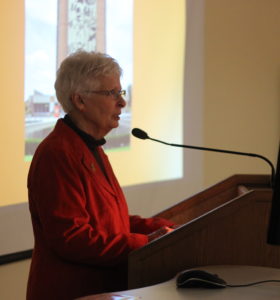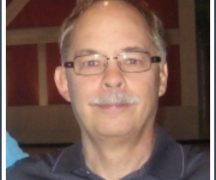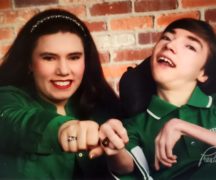By DAVID DUPONT
BG Independent News
Janet Parks wrote the book on women’s athletics at Bowling Green State University.
She authored “Forward Falcons: Women’s Sports at Bowling Green State University, 1914-1982” with Ann Bowers and Adelia Hostetler Muti with design by Jennifer Joseph, in 2010, some six years after she retired after 39 years of teaching in the School of Human Movement, Sport and Leisure Studies. During that time she was a central figure in developing the sports management program.
“Forward Falcons” wasn’t the end of it. Parks remains passionate about telling the tale of BGSU’s female athletes.
Last week she spoke about the development of the Janet Parks Sports History Initiative in the Center for Archival Collections at Jerome Library.
The goal of the initiative, Dean Sara Bushong said, is to document women’s sports at BGSU and in Northwest Ohio, including the legislation and rules the governed and influenced it.

Janet Parks
It’s a story of champions, Parks said. A newly installed photo display on the second floor of Eppler, celebrates those champions.
But to have champions, one must have a governing body to sanction them, and that didn’t exist for women’s intercollegiate athletics until 1971 when the Association for Intercollegiate Athletics for Women was founded.
The AIAW was the culmination of various bodies that fostered women’s sports since 1899 – seven years before the precursor of the NCAA was founded.
“From the beginning it was maintained by women’s physical education teachers,” Parks said. “These women saw athletic competition as an educational experience that was open to all women who wanted to participate.”
When the organization that became the NCAA was formed, it had no interest in women’s sports. “That was fine with women,” she said. They wanted governing bodies run for and by women. And that’s what they had for most of the 20th century.
Some believe, she said, that there were no sports before women until recently. But in 1971, BGSU had 14 teams in a variety of sports. What those teams didn’t have was a chance to compete for state, regional or national titles.
The AIAW changed that. And the Falcon women’s teams distinguished themselves.
“The AIAW brought in an era of champions,” Parks said. “We had champions at this school. We won things. That’s why we keep score, to know who won. Our teams were highly respected.”
Swimming and diving teams and track and field teams and individuals went on to win national titles and All-American honors.
The AIAW was the largest intercollegiate governing body in the country with 960 member institutions in three divisions with 99,000 competing in 19 sports. And creating 1,200 leadership positions, mostly filled by women.
“We were euphoric,” Parks said. “We were in high cotton. We thought this would last forever.”
Then the NCAA came to call with checkbook in hand. It offered schools free membership for women’s teams and financial support to travel to its championships.
The AIAW sued, Parks said, contending the NCAA was a cartel that wanted a monopoly on intercollegiate athletics. The suit failed, and in 1983, the AIAW disbanded.
“That date marks the first time in history that women’s intercollegiate sports programs were not under the direct influence of women physical educators,” Parks said.
Christine Grant, one of the association’s founders and in Parks’ words “an icon in women intercollegiate athletics,” said in 1981 that while the fate of the AIAW was uncertain, “I do know the idea will never die.”
Women’s sports, Parks said, are flourishing with no diminishing of the athletes’ competitive spirit.
The BGSU initiative is another way to keep that idea alive, she said.

Charisse Urbano
Charisse Urbano played basketball at BGSU during the period of transition fro he AIAW and the NCAA. She was among the first to benefit from Title IX. Her scholarship to play basketball allowed her to attend BGSU, her first choice. During her time on campus, she also played volleyball for two years and even club softball for a year. “I knew I had to keep myself out of trouble, and athletics was the easiest way to do that,” she said.
Urbano is encouraging former women athletes and coaches to write down their stories about how their experience as scholar athletes influenced their lives.
“Those lessons they learned on the field and on the court have shaped their careers,” she said. “There isn’t a day goes by when I don’t rely on all those things I learned as an athlete.”
An athlete never loses “the heart of a champion,” she said.
When she graduated from BGSU she coached at the high school level, before concentrating on doing graduate work.
She credited her professional drive to her years on the court. “Female athletes are not scared by hard work and are driven to excel.”
When she was completing her studies to get a doctorate in science education, she could have gotten by with conducting survey. Instead she decided she wanted to do science. So she worked for a couple years in a lab conducting experiments on mice studying the causes of human birth defects.
In her 29 years of teaching at Delta College in Bay City, Michigan, she has designed five courses, going beyond what she was expected.
Urbano would like to create an archive of stories from her fellow athletes about how having a heart of champion has changed their lives.





